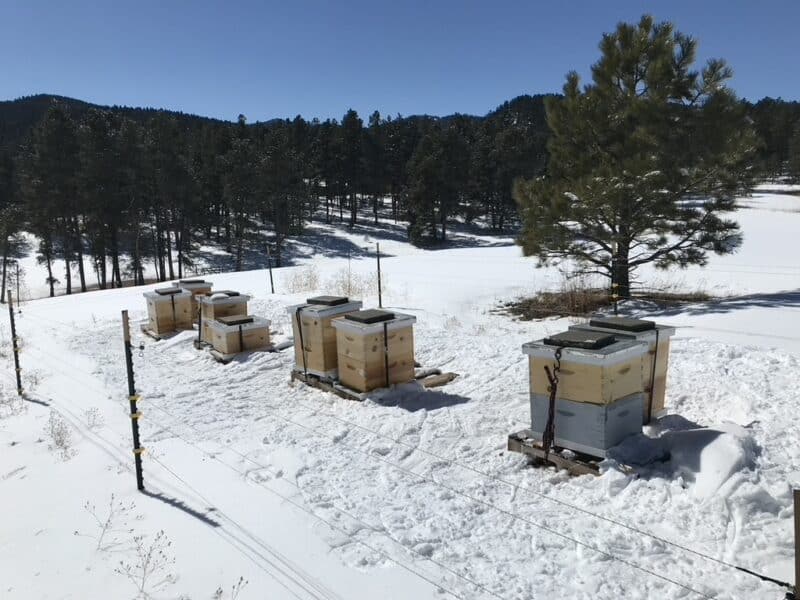Contents:
- History of #SaveTheBees
- #SaveTheBees Today: Are Honey Bees the Problem?
- Biodiversity Role in Pollinator Health
- How Honey Bees Help Guide and Inform
- What Direction We Need To Take
History of #SaveTheBees
In the fall of 2006, David Hackenberg, a commercial beekeeper in Florida, went to check on the hives in his apiary. He found, to his shock and horror, over half of his 3,000 hives seemingly deserted. They were full of honey, but all of the adult bees in the colonies had disappeared into thin air.
This was the first reported case of what would come to be known as Colony Collapse Disorder (CCD) — a mysterious epidemic that caused otherwise healthy colonies to fly away and never return, resulting in the loss of millions of honey bees. Beekeepers were reporting losing between thirty to ninety percent of their colonies, a shockingly high number compared to the previous average of fifteen percent.
The baffling phenomenon was reported on by the media, bringing it to the attention of the general public. The #SaveTheBees movement was born from the urgency to take action against the shocking decline of the honey bees. People were encouraged to support pollinators in a variety of ways, including contributing to the revival of the bee population through beekeeping.
This early 2000s #SaveTheBees movement was heavily focused on honey bees. Aside from prompting people to get honey bee hives and take up beekeeping, it also highlighted other ways to support honey bees: minimizing pesticide use, turning empty spaces into gardens, planting flowers, and more. But the frenzy to save the bees lacked nuance and only scratched the surface of the bigger picture.
#SaveTheBees Today: Are Honey Bees the Problem?
In the last year, there have been an increasing number of media outlets revisiting the issue of pollinator health. Only this time, they’re not worried about the honey bees, quite the opposite — they’re blaming honey bees for declining native bee populations.
The Guardian, New York Times, Washington Post, and more have come out with articles ranging in severity of their condemnation of the honey bees. The April 2024 NYT piece, “Honeybees Invaded My Home, and No One Would Help”, falls on the more extreme side of the anti-honeybee spectrum. It villainized honey bees for the shock factor to draw readers in and capture their attention.
To support the assertion that honey bees don’t need saving, the author references a 2023 study conducted in Montreal in which the researchers found a negative relationship between honey bee abundance and the number of wild bee species.
This study is cited in almost all of the articles, and for good reason — there are very few studies like it. Native bees are notoriously difficult to study; most species are solitary, making monitoring them year over year a herculean task (one that requires excessive funding and time). The Montreal study, and the Paris and Munich studies, highlight the fact that honey bees will outcompete native bees for floral resources. In doing so, they emphasize the importance of plant species richness and abundance in regards to pollinator health — which is not the same as making a data-backed claim that it is honey bees that are the problem.
In fact, the Montreal study says, “We found that the abundance and richness of flowers alone influenced both wild bee richness and abundance … and we detected no influence of honey bee abundance on overall wild bee abundance.”
The media is taking this information and drawing the conclusion that, in order to save native bees, we need to do away with honey bees. It’s a far easier and simpler angle to take than addressing the root of the problem: the need for competition in the first place. But these recent articles leave readers confused and discouraged. We need a data-driven solution that everyone can rally behind; an action-oriented, multifaceted approach to reimagine what #SaveTheBees actually means in the year 2024.
Biodiversity Role in Pollinator Health
By causing biodiversity loss and habitat degradation, we created the need for honeybees and native bees to compete. Rather than eliminate one of the competitors, we need to make it so that there are enough resources to go around, always, for all pollinators. Instead of turning against honey bees for outcompeting native bees for limited floral resources, we have to take responsibility for the part we have played and pick up the mantle of sustainable, conscious environmental stewardship.
To save all pollinators — a goal crucial for the health of our planet — we need to create an abundance of resources. In doing so, we meet the urgent need to reshape our built environment to uplift not only humans, but pollinators and the planet as well.
Sensationalizing the relationship between honeybees and native bees distracts and detracts from the actual goal of #SaveTheBees. Additionally, when we scapegoat honey bees, we overlook the fact that they indicate the health of native bees and the habitats that support them.
With renewed concern about bee health, now is the time to use data to inform how we transform our cities from gray to green.
How Honey Bees Help Guide and Inform
The negative press for honey bees frequently makes the claim that honey bees are an invasive species. The reality is more complicated; honey bees have been in North America for over 400 years, making them an established non-native species. Invasive species are ones that cause great ecological or economic harm in their new environment; honey bees provide the essential ecosystem service of pollination and contribute greatly to our economy. They are a part of our modern world, just like cities and any structures we put up.
Honey bees’ original environment in Europe is similar to that of their environment in North America, so they were quickly and easily integrated into their American ecosystems. Invasive species are frequently able to overpopulate because of a lack of predation, but honey bees are an important part of the food chain for many birds, mammals, arachnids, reptiles, and other insects.
Honey bees are more than just integrated into our environment. They’re an indicator species, reflecting the condition of their ecosystem and any changes made to it.
To be an effective indicator species, a species should have some key characteristics. These include:
- Its response to changes is relatively quick and easy to measure
- It heavily relies on ecosystem health to thrive and reproduce
- It should be relatively common and have a population big enough to easily study
- Its health should be indicative of the health of other species; a species that is uniquely vulnerable would make a poor bioindicator
Some of these key characteristics don’t have anything to do with their responsiveness to environmental change, but rather their capacity to be studied. Honey bees are managed by humans around the world; consequently, they are easily studied and monitored.
Individual bees are vulnerable to environmental stressors, but the honey bee colony as a whole is more resilient and can respond to stressors without collapsing. This allows for long-term monitoring, which means we can map environmental changes in an area as well as study them over time.
We can observe evidence of environmental pollution and pesticide use in honeybees’ mortality rates, cognitive functioning, and birth defects — all of which are more observable and trackable in a beehive of thousands rather than in solitary bees’ nests. These and other factors (reproduction rates, productivity, etc.) reveal patterns over time that provide insight into stress from influences like habitat loss and climate change.
Assessing the environmental health and conditions of a given area is an intricate, complex, and costly process. However, honey bees give us an incredibly powerful tool that helps meet this need: honey. Here at The Best Bees Company, we’ve developed a way to identify the exact percentage of various pollen species found in honey through advanced genomic sequencing. We call it HoneyDNA, and it has the potential to revolutionize ecological surveying.
HoneyDNA allows us to ascertain plant species’ presence, variety, and abundance in the honey bees’ foraging area. It reveals the presence of invasive species, native plant populations, and biodiversity levels in the bees’ environment. This information is critical to the conversation around supporting and protecting native pollinators, and it comes from honey bees.
What Direction We Need To Take
“Honeybees Invaded My Home, and No One Would Help” cites new federal data showing that the number of honey bee colonies has increased 31% since 2007. However, the U.S. lost 48% of backyard beehives from 2022-23, according to the Bee Informed Partnership, the nation’s leading data source for national bee health. Practically one out of every two hives in the US dies year over year.
This discrepancy highlights the lack of tangible, structural change being undertaken to promote and protect pollinators. Honey bees are plentiful, but they are still struggling even with our help. The same things that negatively impact honey bees — habitat loss, depletion of biodiversity and floral resources, environmental pollution, pesticides, and climate change — harm native bees as well.
The spotlight on native bees is a good thing; it inspires more research, education, advocacy, and action. If that energy is diverted to doing away with all urban beekeeping, we’re wasting precious time to actually solve the environmental crisis of our built environment.
As we put in the work, we’ll need a way to measure the impact of rewilding operations, habitat restoration initiatives, green roofing projects, and other efforts. When they are leveraged as data points in a network, like that of Best Bees’ beehives, honey bees serve as both a guiding force, telling us where it is we need to focus our efforts, and as an ongoing monitoring tool, allowing us to track the results.
If we want to improve pollinator health, the most important takeaway is that we need to plant more. We need to plant more native species and flowers rich in nectar and pollen. We need to conserve wild spaces, restore natural habitats, and minimize pesticide use and environmental pollution. If this sounds familiar, it’s because the same things we said would help save honey bees in the heyday of #SavetheBees will save native pollinators as well.
Let’s not distract from the big picture by turning against honey bees — particularly not when they can be a crucial ally in the fight to save all pollinators.






